The Longbox View #004 | Singular Visions 1.2
Batman: The Black Mirror Part2
Writer: Scott Snyder
Artist: Francesco Francavilla and Jock
Color Artist:
Letterer:
Publisher: DC Comics
Spoiler Level: RED
When last we met, we went through the first two arcs of Scott Snyder’s The Black Mirror: the eponymous “The Black Mirror” and “Skeleton Cases.” This brought us through the introduction of the Mirror House, a depraved auction site for people who revere evil, and into the introduction of Commissioner Gordon’s returning son, James Gordon Jr. This brings us to…
Lost Boys
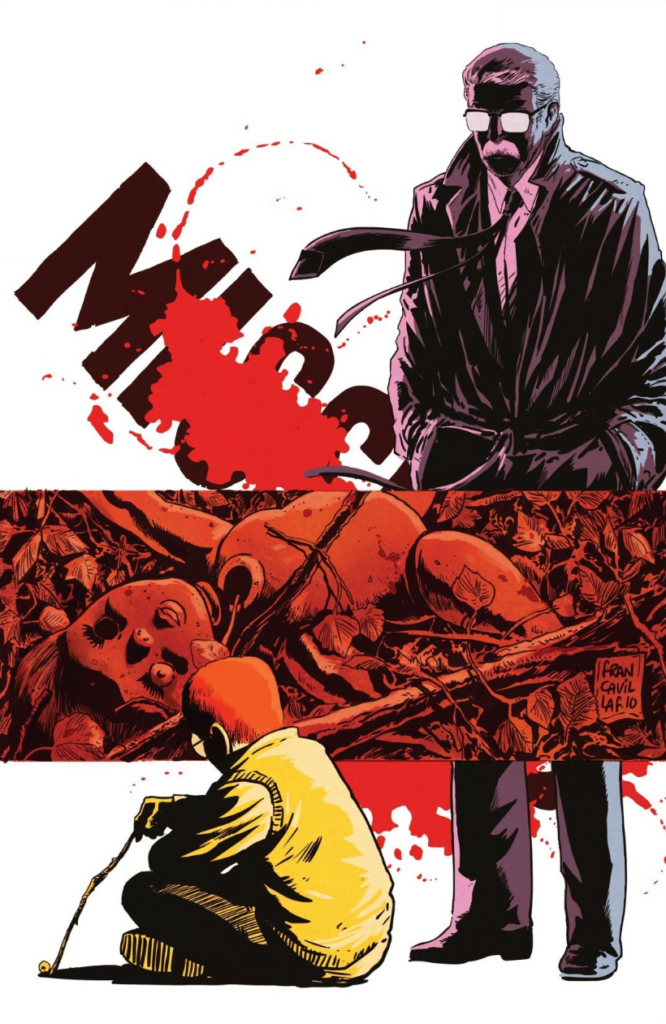
Lost Boys is a standalone issue within the larger story, and fully introduces James Jr., his past and his difficult personality to the Bat mythos. First, though, we have Harvey Bullock noiring it up in his detective “costume”- a career-appropriate suit and hat – standing on GCPD rooftop, bat signal behind him.
It’s here, in these opening pages, that we get a sense of Snyder’s take on the city: Gotham keeps changing, pulling the proverbial rug out from under you. And in a place with so little constancy, a person has to find their own balance, set up their own safe place – not unlike a local bird whose nest we see perched on a nearby ledge. A peaceful scene… until Bullock looks closer and sees the rat sitting amongst the broken eggshells, devouring the baby birds.

Like vultures and birds of prey, like the shades that haunted Dick’s drug-addled mind last time, Gotham can’t be trusted. Gotham has teeth. And in the moment when you feel safest, Gotham will bare them. Gotham devours.
Most of all, though, Gotham is a city of masks – literal masks as worn by its defenders and villains alike, and metaphorical masks, like snow covering the grime, or the pristine look of an average person worn over the soul of a psychopath.
And speaking of that.
“Psychopathy” is, technically, not a thing – at least not anymore. The medical term these days is Antisocial Personality Disorder, but I like to use psychopath (or sociopath) in some contexts because the use of those terms instead of ASPD provides a context that ASPD does not. A person with ASPD isn’t generally dangerous – and the term should not be used to imply that they are. But if you say “psychopath,” the images it conjures are pretty straightforward: a psychopath isn’t your coworker with ASPD. It’s Charles Manson, it’s Ted Bundy.
It’s Roy M. Blount.

Blount is the monster in Commissioner Gordon’s memory closet – a mild-mannered former convict who owns a small cleaning business and is also a serial child murderer. Despite having claimed eight victims fifteen years before the start of our story, Blount was never convicted for any of the murders… and while he has been to prison in the past, it has always been for smaller crimes. Casualty-free crimes. The kind of thing that can be forgiven with enough time served, and with enough years of straight living, he becomes normal again, at least on the surface. He rejoins society. Blount’s face is, in short, as much a mask as any cowl or domino.
And that’s where he overlaps with James Gordon Jr.
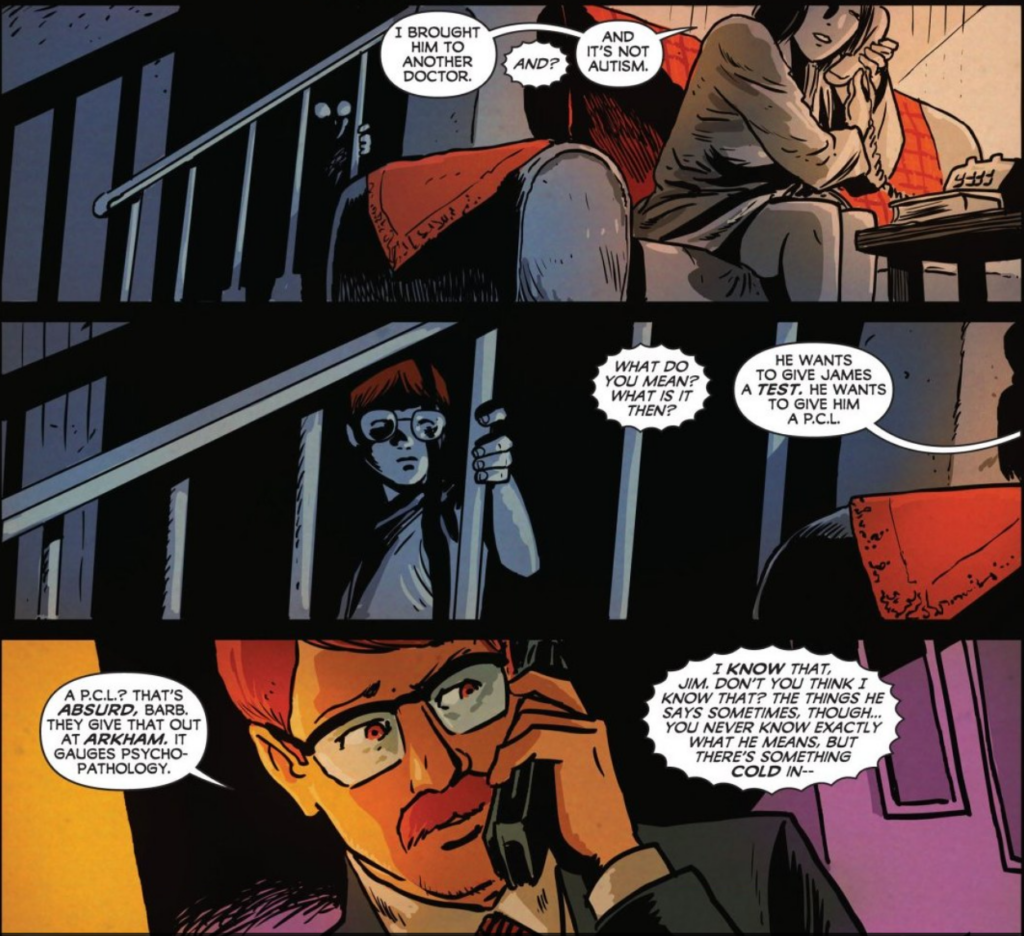
As a child, James is off-putting even to his mother, who feels the strangeness of him but isn’t sure how to put it to words. Jim, he’s a father, but he’s also a veteran detective – he can see the “dark spark” in a baby who doesn’t cry, whose classmates mysteriously fall ill when he’s displeased with them – a grade school kid who casually disembowels a bird and dresses as the Joker for Halloween. That last one is grade A fridge horror. So, Jim can see that there’s an issue, but even so he balks at allowing therapists to administer the psychopathy checklist to his son. After all, just as he’s a father but also a detective… he’s a detective, but also a father.
Still, all that came before pales in comparison to what happened when the Gordons took James and Barbara on a family vacation during which Barbara’s longtime friend, Bess, disappeared.
Officially, Bess’s disappearance remains unsolved. But there has long been a whisper of suspicion floating through the Gordon household – the belief that James, only a child at the time, may have been responsible.
To understand why, we have to rewind.
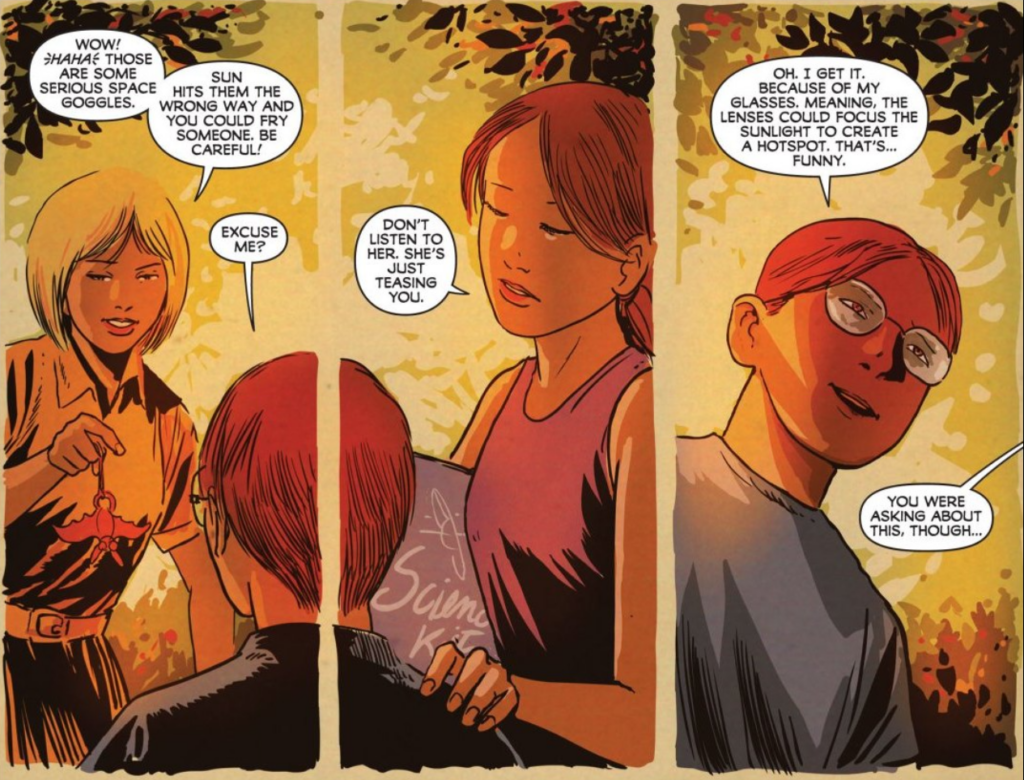
Picture this: The Gordons – Jim, Barbara, James Jr. and Jim’s second wife, Sarah – arrive at their comfortable summer house, and are greeted by Bess, a science curious girl Barbara’s age. The friends share custody of a science kit, Barbara with the kit itself and Bess with the key, so that they can only use it together. Bess takes note of James Jr’s glasses, makes a little joke about them; James fiddles with the lock on the kit and nearly breaks it. Later, Bess leaves for home. She walks through the woods, passes beside a river. A shadow falls over her, and—
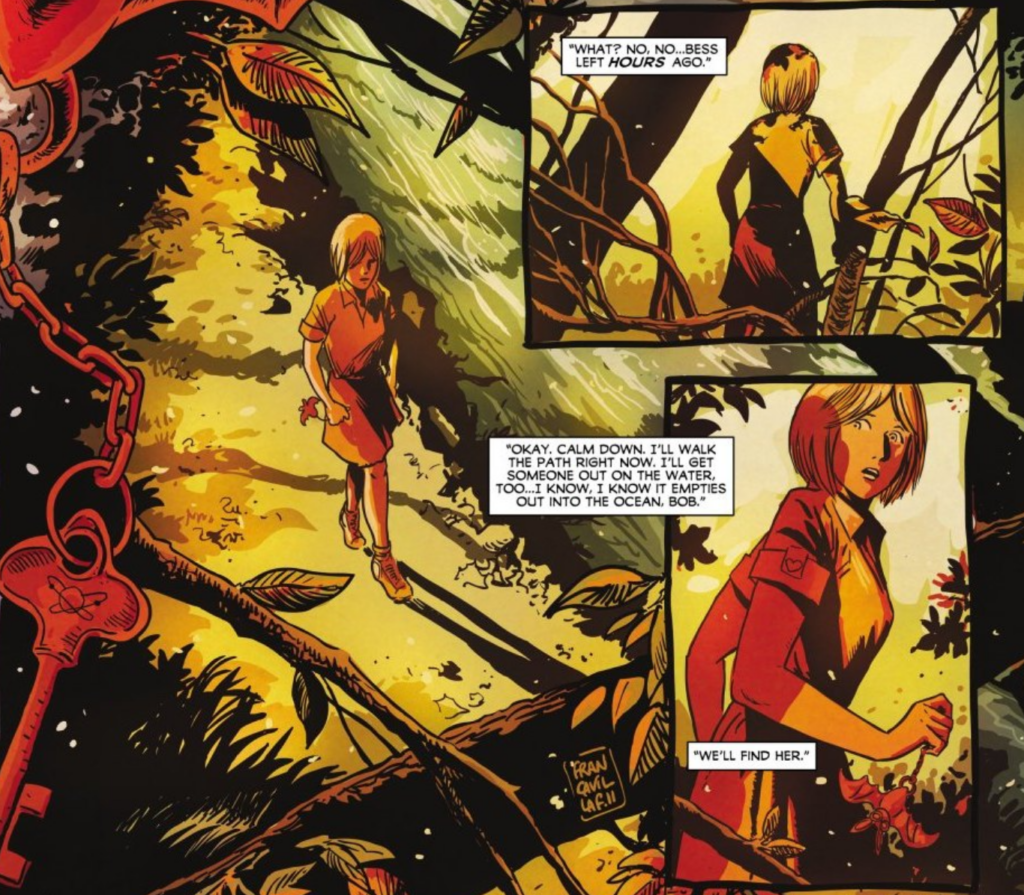
–that’s the end of Bess’s story. Her body is never found. It isn’t even certain that she’s dead. She’s a teenager, after all, sometimes they run away.
But.
The only thing is.

When Jim goes upstairs to speak to James, he finds his son alone… hunched over the unlocked science kit.
What happened to Bess? The suspicion against James is an open secret within the Gordon family, but that old question is reopened when Jim follows Blount on the hunt and the ultimate confrontation reveals that Blount was in the area the day Bess disappeared. Having noticed Jim was on his tail, Blount decided to strike rather than wait to be struck and went after James Jr… only to look at the little boy’s eyes and find himself staring into the void.
Blount is captured, but he has resurrected a long unanswered question that has lingered like an old wound for all these years. And when Batman (Dick Grayson version) informs Jim that surveillance footage from inside Gotham Aviary has shown that the rare birds (freed last arc, covered last column) were let loose by some random skater kids rather than by James as suspected… everything Jim thought he knew becomes unsettled.
Jim is a father – he wants to believe his son is salvageable. Now he has the means to construct that belief.
Did Blount kill Bess? Is that yet another crime that Jim has unfairly pinned on James, in his mind, if not in words?
Maybe James is a person with ASPD, but not a psychopath.
Maybe Jim’s son really isn’t the monster he’s been made out to be.

Hungry City
The state of James’ personality disorder can wait for a moment; the page turns, and so does the tale. Despite that, many of the players remain. I’m not only referring to the obvious – the human players in the show – but also to the themes that echo throughout. The long shadow cast by accomplished and famous fathers, good or bad. The places where parent and child differ and overlap. The ever-evolving monster that is Gotham, waiting to crush, rend and devour you, then spit you out broken.
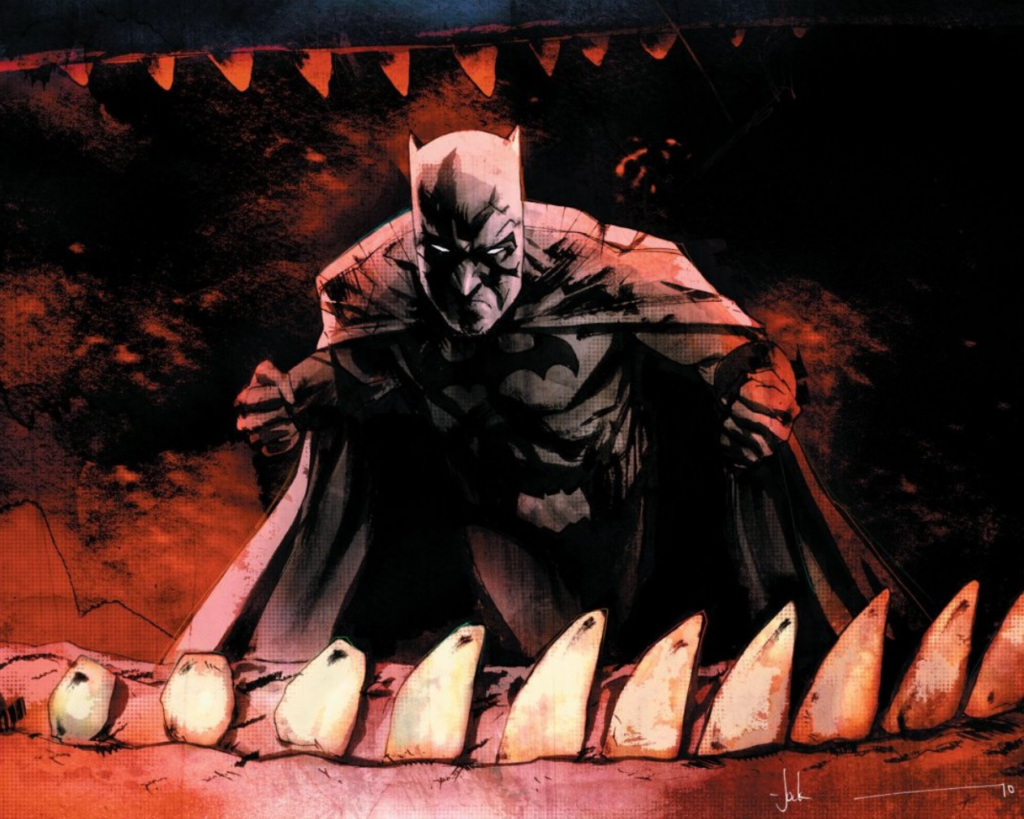
General you, of course.
Exhibit A: the lobby of relatively new Gotham Global Modern Bank and the killer whale carcass deposited at some point before the opening bell on an otherwise normal Tuesday morning.
Exhibit B: the corpse of Evelyn Marr, personal assistant to Gotham Modern head Sonia Branch. Evelyn’s body falls, undigested, out of the whale’s stomach and onto the floor of the crime lab where Dick and Jim Gordon are discussing the case, among other things.
Those other things are primarily the prodigal son, James Jr. He has recently taken a position helping longtime Bat-surrogate mom Dr. Leslie Thompkins at her free clinic in Crime Alley. Under normal circumstances this would be fine, but James Jr. is known to suffer from antisocial personality disorder, and worse he has cruel impulses that seemingly make him dangerous.
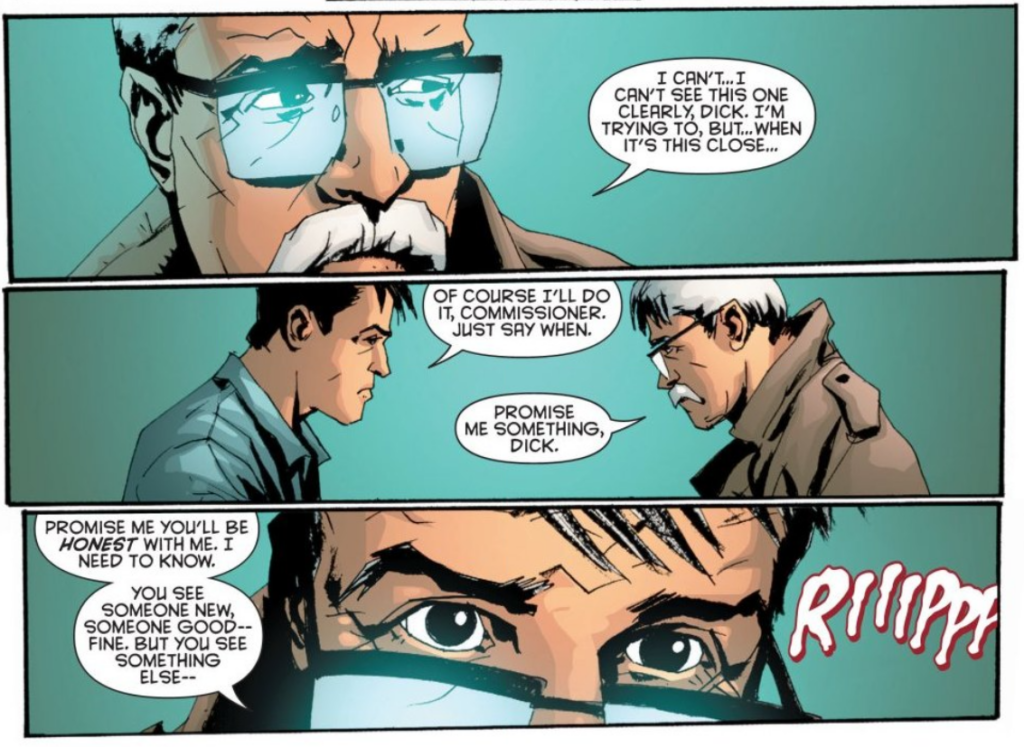
Or does he? That’s the thing, Jim doesn’t know – he can’t see it, he’s too close. So, he enlists Dick to go and meet with James and assess whether he is safe to be around, whether he’s changed. For Jim standing on a precipice, his instincts as a father and as an officer at war, all he can do is reach beyond himself to someone who knows James enough to have a feel for him, but not enough to be biased. However, in doing so I would argue he leaves out a key bit of information that leads to a disastrous oversight later in the story.
But before we get there of course, we must deal with our orca, whose arrival should be easy enough to find on CCTV footage, but someone has managed to excise the time around its delivery from the video. That leads to Sonia Branch, nee Sonia Zucco. She is the daughter of infamous Gotham gangster Tony Zucco – the man who killed Dick’s parents.
The dead woman, Evelyn Marr, was Sonia’s assistant – and her friend.
Gotham Modern is Sonia’s bank.
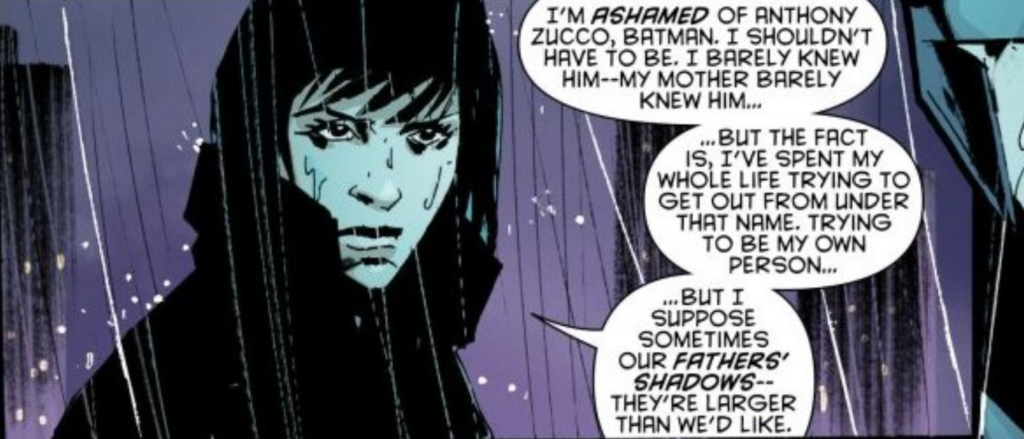
Considering these truths, Dick can perhaps be forgiven for approaching her with skepticism, but he ultimately finds that he has more in common with her than he’d thought. Their relationships with Zucco and Bruce are directly opposite – Bruce is Dick’s father in all but blood where Zucco is Sonia’s in only blood –but each carry a similar weight, even so. For all that Sonia tries to be her own person and escape her father’s name, Zucco and his reputation loom large in her life, and she often finds herself trapped inside his legacy. She mentions this during their second conversation – a double page spread with Dick’s face in the center, hidden inside his father’s cowl. He can relate. She gets the benefit of the doubt.
Dick, James and Sonia form a triad of sorts – the younger generation separated from or bonded to their parents by the old chains of nature and nurture. While Bruce’s tutelage may have given Dick many of his abilities – his martial arts, his detective skills, his passion for law and justice – there is a great deal about him that is unique to him. Where Bruce thrives in the trenches, up close, Dick sees the world most clearly from above where he can view the larger picture and calculate from there – not unlike the dive bomber he knew as a child, judging the distance and angle of his near impossible jumps in order to emerge unharmed. And where Bruce’s idealism is cut with a healthy dose of cynicism, Dick’s is flavored with empathy – no doubt a gift of his parents, who were performers more than capable of feeling the energy in the air. That empathy is among his greatest strengths. It is also the weak link in his armor.
Now, there has long been a debate over whether nature or nurture is more formative in determining an individual’s “self,” current theory has rested on “Well, both really” – in simple terms, genetics determine a range of potential outcomes, and environment determines where the needle falls.
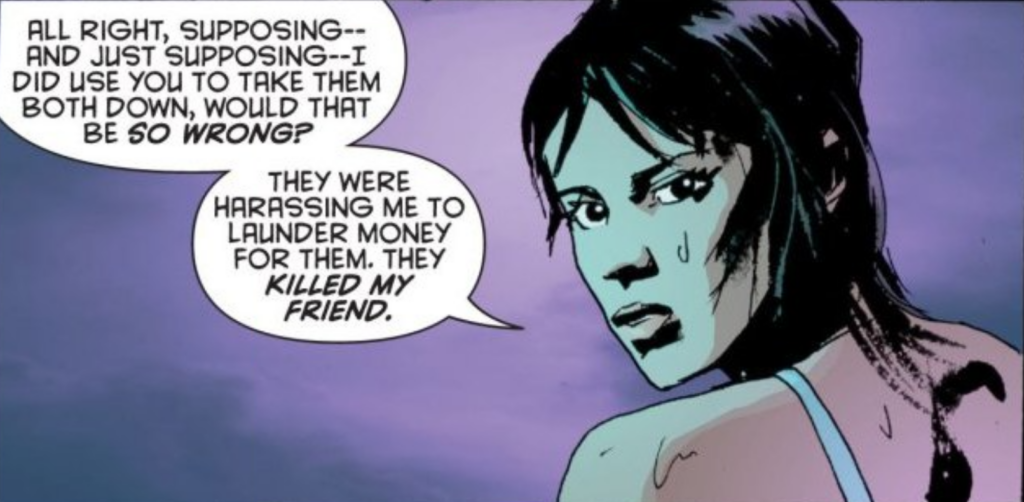
From that perspective perhaps it isn’t surprising that someone like Sonia turns out to be who she is: an honest citizen, yes, but manipulative, ruthless. As it turns out, she is the one who destroyed the relevant surveillance footage to prevent the whale toting culprit from being immediately identified. Her goal? To weaponize Batman and take down both of her enemies. Her puppeteering nearly costs Dick his life and ultimately allows her friend’s murderer to escape, but when this is pointed out, Sonia is unimpressed.
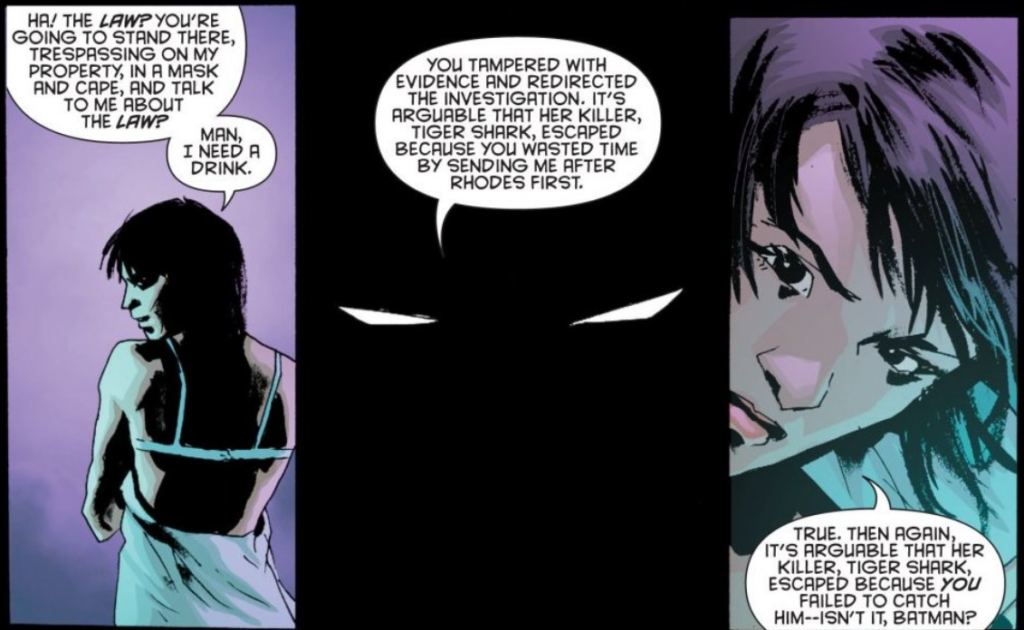
And there it is – the weak spot in his armor. He related to her, he empathized. He saw himself in her plea for the recognition of her individuality and overlooked the red flags in his desire to believe the best of her. He misjudged.
A minor error. This time.
But before we go on, let’s talk about that dive bomber. This is a circus anecdote Dick tells in narration: when he was a child, dive bomber Francis Roy told him that the trick to diving safely into shallow water nightly was not in the fall, it was in the preparation – observation, judgment, deciding when to jump. And hundreds of times, he got it right, and he made it look easy.
Until the one time when his judgment was just a fraction off, and he made a bad jump. He died instantly; neck shattered on the circus floor.
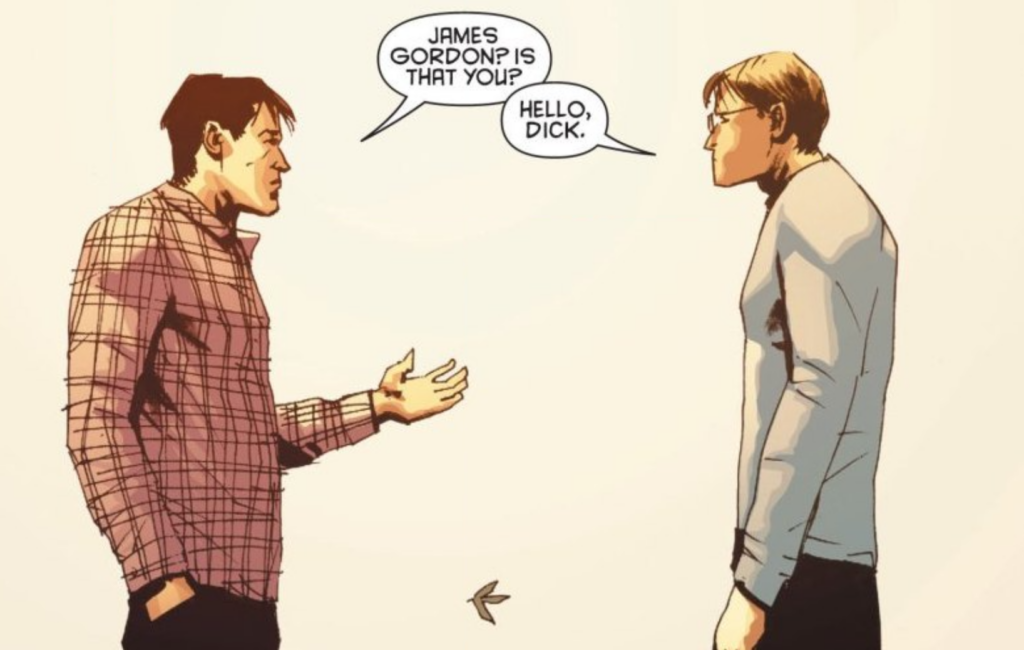
Dick agrees to Jim’s request. He goes to meet James Jr and get a sense of him. Having already spoken to Leslie Thompkins, he knows James has been doing well, but he’s a little unprepared for how well. They catch up briefly, reminisce over Ben Wolff, a boy who stole James’ glasses at a picnic 12 years ago — the last time Dick and James met. As it happens, James recently ran into Wolff and he’s blossomed into a great guy – proof that people can change, even if they sometimes don’t.

Dick goes his way then – back to Sonia and the dead whale case. Unaware, even as he corrects one miscalculation, that he has already made a much worse one.
Because James goes his way, too – back to where he’s staying, which happens to be Ben Wolff’s house, currently quiet and occupied by two.

The first, of course, is James.
The second is Ben Wolff, hanging from the ceiling in the basement, dismembered, surrounded by his own rotting limbs, his excised jaw… and yet, somehow, still alive.
Across the city, Dick jumps… embraces the air… and begins spiraling toward the circus floor.
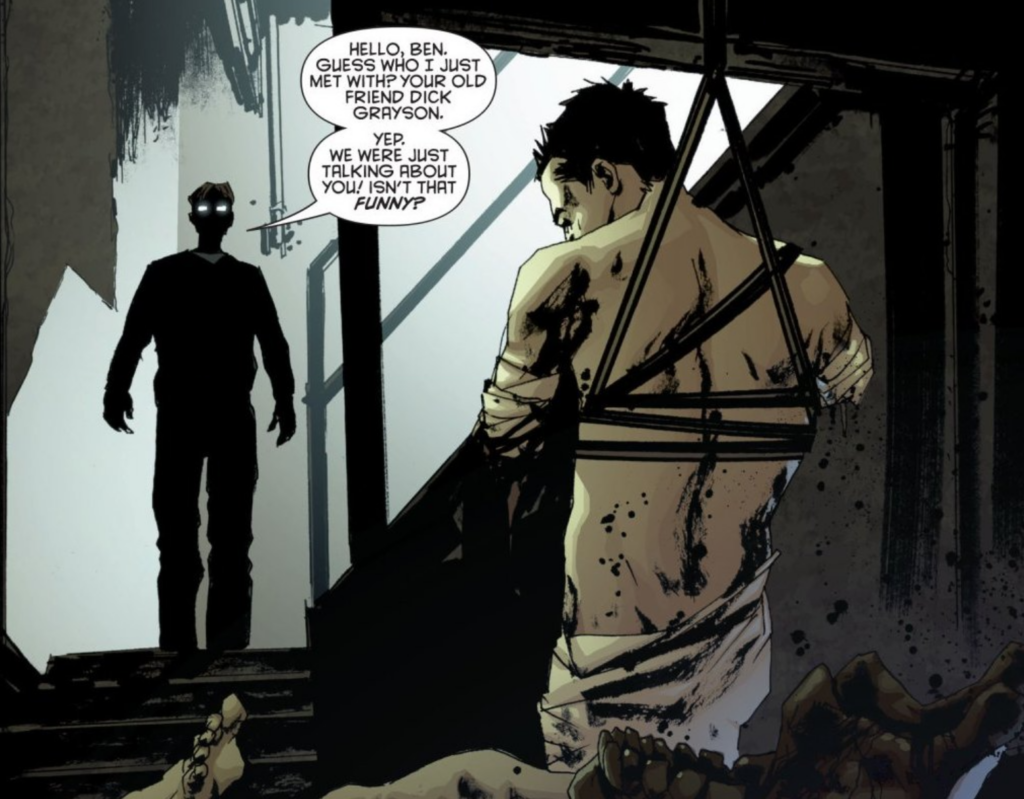
So, as it turns out, due to a mixture of being verbose and having work obligations, I need one more column for this. I’m also working on a special something. If it works out, you will know soon! If it doesn’t, pretend I never said anything! But for now…
Next time on The Longbox View… One column, three issues, the culmination of this collection. James Jr’s true face is revealed, and it’s left to Dick and the Gordons to deal with the fallout.
Until then, stay safe and keep reading!
ARIEL BEE IS… An Old Person. A Comics reading veteran. Mostly involved with DC and indies but happy to go on the occasional Marvelous Mission into the unknown. An analytical overthinker. Also found as a reviewer on Comics-Watch and Twitter @thearielbee.


